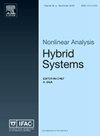使用ProbStar可达性对可学习系统进行定量验证
IF 3.7
2区 计算机科学
Q2 AUTOMATION & CONTROL SYSTEMS
引用次数: 0
摘要
深度神经网络(DNN)验证主要侧重于定性验证,确定DNN是否违反了安全性或鲁棒性。本文介绍了一种前馈神经网络(FFNN)定量验证的新方法,将定性评估转化为概率评估。由此产生的定量验证方法不仅可以回答YES或NO问题,还可以计算属性被侵犯的概率。为了做到这一点,我们引入了概率星(ProbStar)的概念,这是众所周知的星集的一种新变体,其中谓词变量属于高斯分布。我们进一步提出了一种计算高维空间中概率星的概率的方法。与现有处理约束输入集的工作不同,我们的工作将输入集视为截断的多元正态(高斯)分布,即,除了对输入变量的约束外,输入集具有满足约束的概率。输入分布被表示为一个概率星集,并通过网络传播,以构建包含多个ProbStars的输出可达集,这些ProbStars用于验证网络的安全性或鲁棒性。在违反属性的情况下,违反概率可以通过精确验证算法精确计算,也可以通过过近似验证算法近似计算。在此基础上,我们将定量验证框架扩展到支持学习的网络物理系统(Le-CPS),其中分段线性FFNN控制线性物理工厂模型。我们的方法能够构建Le-CPS的概率可达集,允许对财产侵犯进行定性安全/不安全评估和定量概率计算。我们已经在一个名为StarV的工具中实现了我们的验证框架,并在基准测试中评估了其有效性,包括HorizontalCAS和ACASXu网络,一个火箭着陆系统,以及Le-CPS领域的先进紧急制动和自适应巡航控制系统。本文章由计算机程序翻译,如有差异,请以英文原文为准。
Quantitative verification of learning-enabled systems using ProbStar reachability
Deep neural networks (DNN) verification primarily focuses on qualitative verification, determining whether a DNN violates safety or robustness properties. This paper introduces a novel approach for quantitative verification of Feedforward Neural Networks (FFNN), transforming qualitative assessments into probabilistic evaluations. The resulting quantitative verification method not only can answer YES or NO questions but also can compute the probability of a property being violated. To do that, we introduce the concept of a probabilistic star (or shortly ProbStar), a new variant of the well-known star set, in which the predicate variables belong to a Gaussian distribution. We further propose an approach to compute the probability of a probabilistic star in high-dimensional space. Unlike existing works dealing with constrained input sets, our work considers the input set as a truncated multivariate normal (Gaussian) distribution, i.e., besides the constraints on the input variables, the input set has a probability of the constraints being satisfied. The input distribution is represented as a probabilistic star set and propagates through a network to construct the output reachable set containing multiple ProbStars, which are used to verify the safety or robustness properties of the network. In case a property is violated, the violation probability can be computed precisely by an exact verification algorithm or approximately by an over-approximate verification algorithm. Building on this foundation, we extend our quantitative verification framework to Learning-Enabled Cyber-Physical Systems (Le-CPS), where a piecewise linear FFNN controls a linear physical plant model. Our approach enables the construction of probabilistic reachable sets for Le-CPS, allowing for both qualitative Safe/Unsafe assessments and quantitative probability computations of property violations. We have implemented our verification framework in a tool named StarV and evaluated its effectiveness on benchmarks including HorizontalCAS and ACASXu networks, a rocket landing system, as well as advanced emergency braking and adaptive cruise control systems within the Le-CPS domain.
求助全文
通过发布文献求助,成功后即可免费获取论文全文。
去求助
来源期刊

Nonlinear Analysis-Hybrid Systems
AUTOMATION & CONTROL SYSTEMS-MATHEMATICS, APPLIED
CiteScore
8.30
自引率
9.50%
发文量
65
审稿时长
>12 weeks
期刊介绍:
Nonlinear Analysis: Hybrid Systems welcomes all important research and expository papers in any discipline. Papers that are principally concerned with the theory of hybrid systems should contain significant results indicating relevant applications. Papers that emphasize applications should consist of important real world models and illuminating techniques. Papers that interrelate various aspects of hybrid systems will be most welcome.
 求助内容:
求助内容: 应助结果提醒方式:
应助结果提醒方式:


